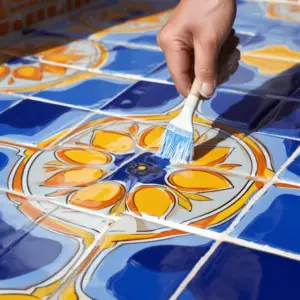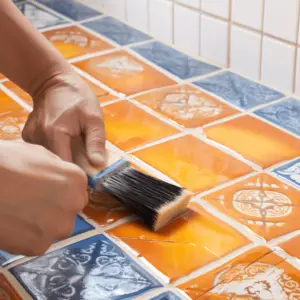Grout Painting and bathroom walls are always prone to moisture and they tend to collect dirt, grime, and mildew right after the installation process.
And even though tiles are fairly simple to clean, eliminating build-up dingy discoloration from more porous grout can be hard enough.
Whether your current grout lines have become dirty or discolored, or you’re just looking to achieve some new looks, there are effective ways to change or improve the color without having to tear out the entire tile job and starting over again.
You can change the grout lines by tinting them with a colorant, or grounding it entirely and replacing it with fresh grout that comes with the desired color. Having said that, one common alternative to time-consuming scouring and costly re-grouting is low-cost grout paint.
It is a quick and easy method, especially considering that today’s decorating styles mostly call for colored grout that complements or contrasts with the field tiles.
Table of Contents
What is Grout Paint?

Grout paint, made from latex, fillers, and pigments, restores or changes grout color. Grout paint is usually brushed on. It colors grout without damaging tiles.
Grout paint comes in several hues, so it may match any design. The compound goes beyond backsplashes. Because many grout paints can be used indoors and outside on walls, floors, and other surfaces.
So, Can You Paint Grout Lines?
If you are still wondering if you can paint over the grout, the answer is yes. You can always apply grout paint. In case you want something new, you can consider painting the grout to look new or paint it a different color completely.
DIY grout paint projects online can also teach you a lot. You’ll learn to paint anything you choose.
Please note that grout paint is not suitable for all tiles. Tile grout paint is for glazed or sealed tiles, not natural stones or terracotta.
Grout paint will obviously seep into unsealed material and flashing it off later may not be effective. If you’re trying to paint the grout between unsealed tiles, consider using a tile sealer to the tiles first. Follow the manufacturer’s instructions and let it dry completely before you start applying grout paint.
Otherwise, if you were looking for a short answer, it’s yes. Painting the grout lines on your tile floor can be a quick and easy update for your home. You just need to make sure you’re prepared for this project in order to achieve the best results.
Painting Grout Lines: How to do It Effectively
When new and freshly applied, grout looks great and may even enhance the look of your favorite tiles. However, as the days go by, its crispiness tends to fade off, which makes the initially clean color start to look dirty, no matter how well the walls or the floor is cleaned.
Some people think that the only effective solution is to re-grout the area under concern in order to refresh the look. But as we have seen, grout paint can restore the grout to look like new or even update the tint to a different tone completely, if you’re someone who fancies trying something new.
Note that the paint used for painting grout between lines is specially designed for such purposes. The compound itself is more of an epoxy colorant and not so much a conventional paint, meaning it can last many years after application.
Unlike regular wall paints, which tend to flake or peel off after some time, grout paints are available in many colors and will stick. A second coat may be necessary though.
If you’re planning to take on some grout painting projects, remember that the key to satisfactory results is the preparation of the surface. Poorly prepared surfaces can easily lead to cracking. Below are some of the important things to keep in mind during preparations.
Grout Painting Tools

Grout is applied between tiles with a special paint specifically made for it. Thankfully, there are lots of painted grout line tutorials on the web, most of which show the process of painting with specialty grout paint pens or small intricate artist brushes.
Just like any other paint, the grout paint will require clean conditions, or else it will not stick properly. Use a strong tile cleaner to remove any build-up of gunk on the grout and tiles. Make sure the windows open when doing this as some cleaners are quite strong in smell.
You’ll also need to have the right brush for the job. Brush size is particularly crucial when it comes to painting a grout line. The ideal brush should be almost exactly the width of the grout line. If it’s small, you will have to paint more than once to cover the entire grout.
Quality is equally important when it comes to brushes. A cheap brush will shed its bristles frequently and stick in the paint. When starting out, flick the brush with your fingers to get rid of loose bristles ahead of time. Do this even with a quality brush to prevent the bristles from getting in the paint. Painting grout lines will require you to have paint that’s specifically made for grout.
Lastly, cleaning is important. Although it may be tempting to paint the grout rather than scrubbing it to eliminate dingy build-up, grout requires clean conditions to adhere properly.
Without proper cleaning, the end results will be fine new-looking grout in some areas and grimy, old-looking grout in others.
